The Anaheim Ducks added to their growing pipeline of prospect talent in the 2021 NHL draft. Several of the picks they made they were able to get much later than the consensus expected they would be able to. According to the Hockey Prospecting model, the Ducks have the second-best prospect system in the league, primarily buoyed by their excellent skater depth. Only the Los Angeles Kings are ahead of them and all California teams are in the top 5.
For the purposes of this list, we will use the criteria defined by Hockey’s Future. A skater will be considered a prospect if he has played fewer than 65 NHL games or is younger than 24 years old by season’s end. A goalie will be considered a prospect if he has played fewer than 45 NHL games or is younger than 24 years old by season’s end.
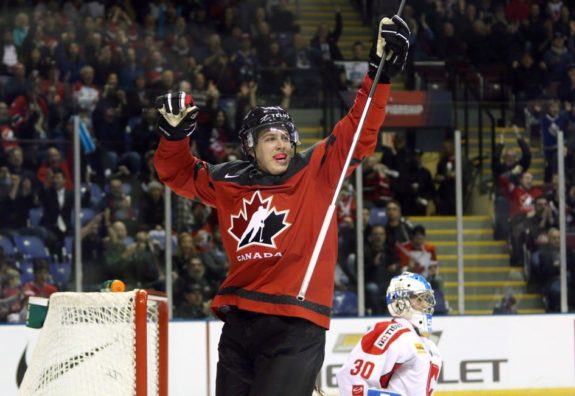
Even though the Ducks recently graduated prospects Maxime Comtois and Isac Lundestrom, they are still in prime position to compete for a playoff spot in the near future. It is especially exciting that their top tier of prospects contain a likely future starting goalie, top line center, and top defenseman. Those three pieces are what every team covets, and if all breaks right, the Ducks will have that in the future.
Tier 1: The Top Players – Trevor Zegras, Lukas Dostal, Jamie Drysdale
Trevor Zegras had a fantastic 2020-21 season. The 2019 ninth-overall pick for the Ducks began the year with a performance to remember at the under 20 World Junior Championship (U20WJC). The then 19-year-old led the tournament in scoring with 18 points in seven games enroute to upsetting Canada in the gold medal game. Zegras was named the most valuable player of the tournament, a nod to his absolutely dominant performance. It’s worth noting too that his points were evenly distributed as goals and assists, even though he is primarily known as a setup man. It seems like he has found a new scoring touch, which will serve both him and the Ducks very well.
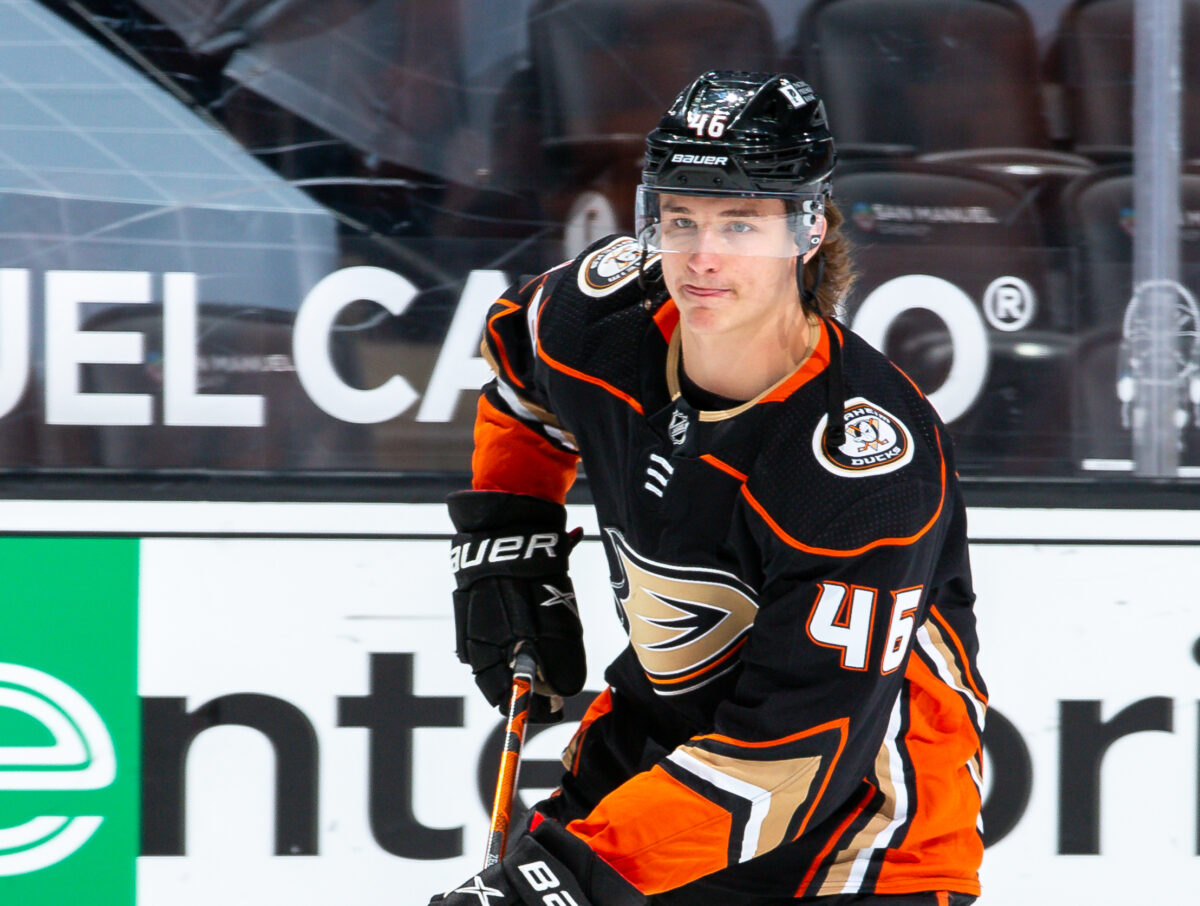
After the U20WJC, Zegras had nine points in eight American Hockey League (AHL) games for the San Diego Gulls before making his NHL debut. In his first tour in the NHL, his ice time fluctuated, and although he was effective, there were aspects of his game the team wanted him to work on. Specifically, they want him to be a center in the NHL, so he was sent down to the AHL at the beginning of April for that reason. In that first stint, he didn’t win very many draws, just two in 17 games. When he returned to the NHL on April 29th, he was winning an average of six face offs a game.
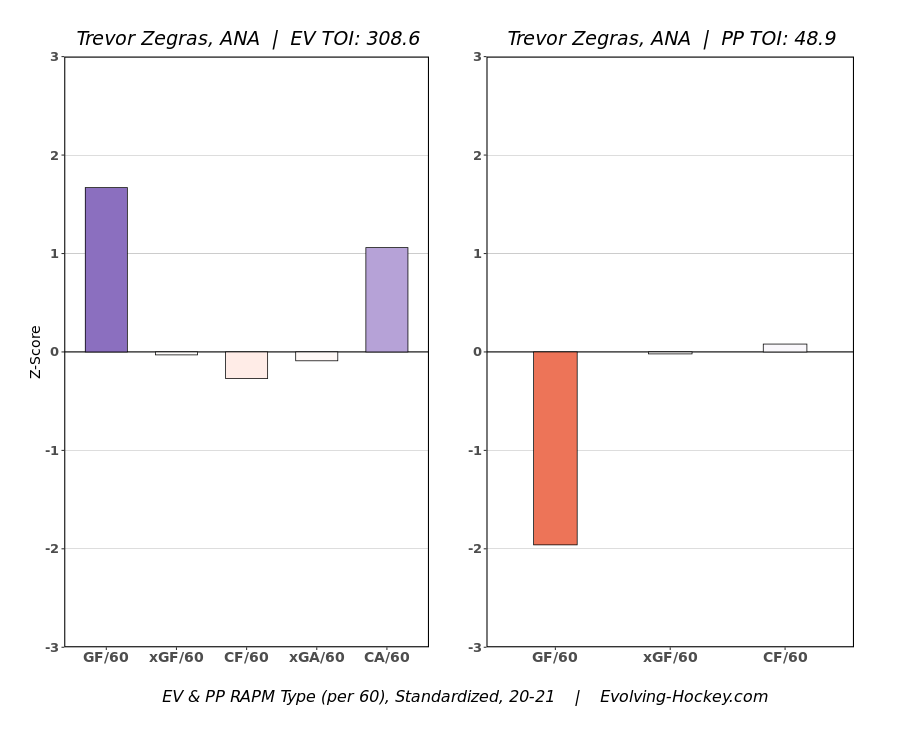
Zegras has the skill set to be a top line center in the NHL. According to Evolving Hockey, in this first year he already outperformed his NHL peers in goals-for per 60 minutes, and Corsi-against per 60 minutes. Of course, he still needs to work on details of the game, but clearly the potential is there. Zegras will no doubt graduate from this list and spend the majority of his time in the NHL in 2021-22. Since he played 24 NHL games in 2020-21, he is eligible for the Calder Trophy as rookie of the year in 2021-22, and he is one of my favorites to win it.
Lukas Dostal is not only the best goalie prospect in the Ducks system, he is clearly one of the best prospects in the system and a top prospect in the league. He somehow did not make the top ten list from our very own Greg Boysen back in May of 2021. Regardless, he is an excellent talent and the Ducks have their heir apparent to John Gibson.
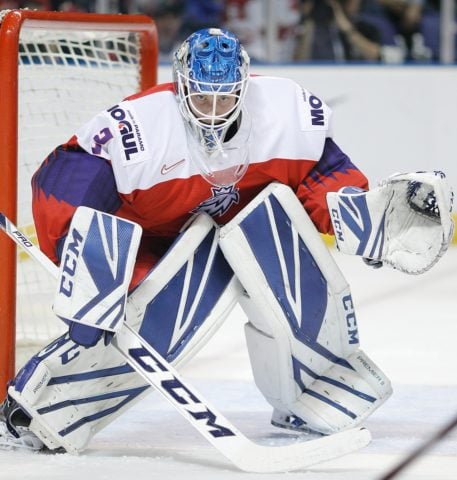
The 2018 third-round pick just turned 21 and completed three stellar seasons in the Finnish Liiga after being drafted. Dostal played for Ilves, and recorded save percentages of .922, .928, and .941 in the past three seasons. Ilves finished fourth, eighth, and fourth in the Liiga the past three seasons out of 15 teams, so his .928 season when they were a middle of the pack team was most impressive. In addition, Dostal has had an extremely positive 1.5 and 2.1 expected goal per goal conceded (xGPG) the last two seasons, meaning he is consistently giving up fewer goals than expected.
Dostal’s dominance continued outside of Finland as he made the transition to the AHL after 11 Liiga games in 2020-21. Dostal was 19-9 with a .916 save percentage and 2.87 goals against average. Most impressively, he was able to maintain a high xGPG in the AHL for the San Diego Gulls with a mark of 1.68. It seems like he is not just a product of playing a on a strong Liiga team.
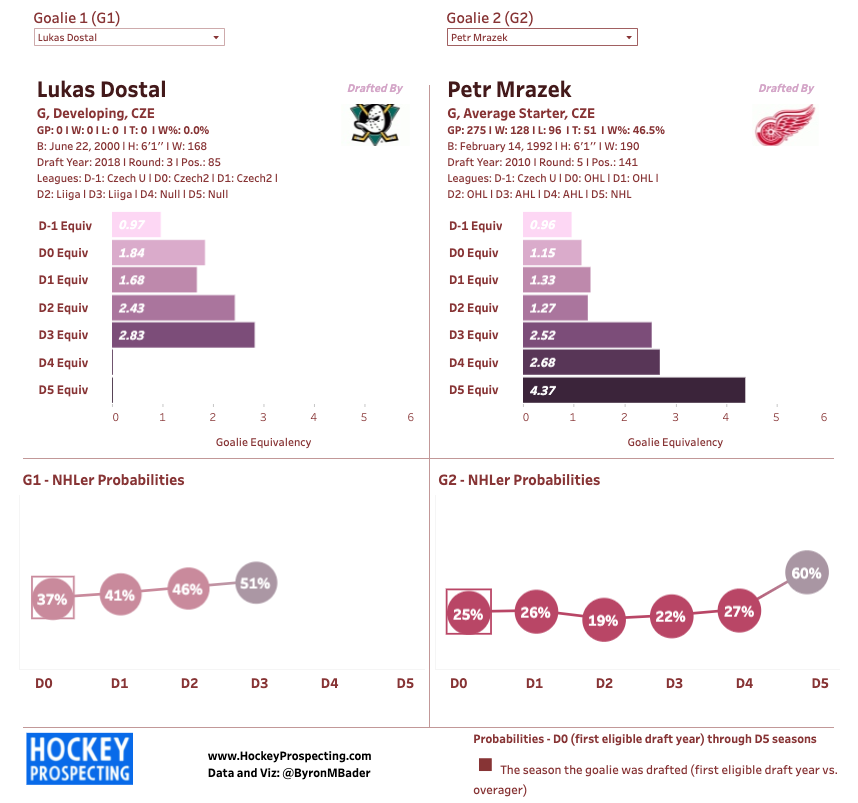
The Hockey Prospecting model has Dostal at a 51 percent chance of becoming an NHL regular after his third season post-draft. Comparing his numbers to a contemporary countryman netminder in Petr Mrazek, Dostal has more than the double the probably of being an NHL regular than Mrazek did at the same developmental point. Mrazek’s 275 NHL games with a .911 save percentage are a testament to his longevity in the league. Dostal should be able to best those numbers. Dostal is ready for a shot in the NHL, but the Ducks don’t need to rush him. With Anthony Stolarz signed for two more seasons, the Ducks can be patient with Dostal, though he might earn a spot earlier than expected.
After being drafted sixth overall by the Ducks in 2020, the 5-foot-11 Jamie Drysdale jumped straight to the AHL after putting up nearly a point per game for the Erie Otters in 2019-20. Prior to his AHL start, he played a prominent role on the Canadian U20WJC team that won silver in Alberta in 2021. His first 14 AHL games went fairly well, scoring eight points and playing over 20 minutes on most nights. Toward the end of his first 14 game stint, he was playing over 25 minutes.
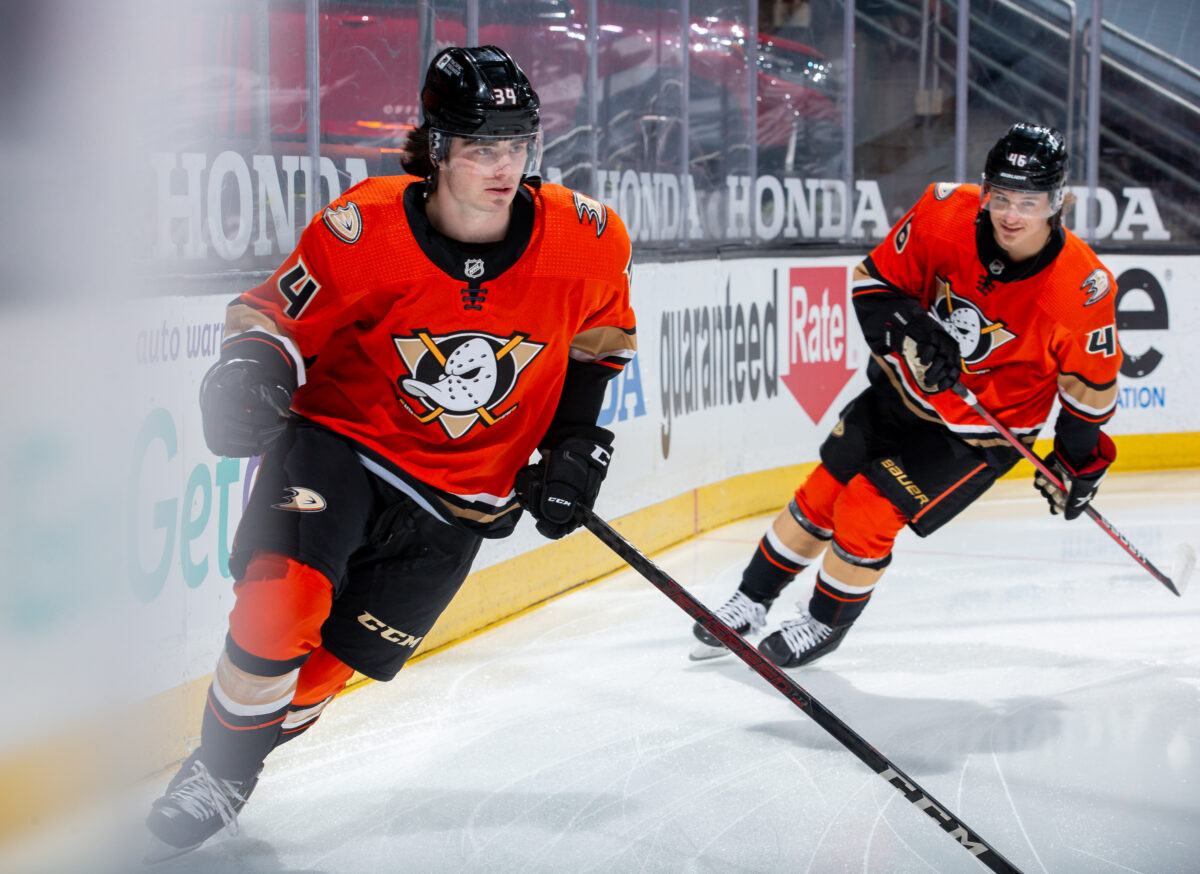
His strong play earned him a call up beginning on March 19th, 2021 where he remained for the rest of the season. Drysdale was impressive in the NHL, particularly for an 18-year-old. While he had the lowest Corsi % and expected goals differential for defenders on the team (per Evolving Hockey), he showed improvement in his confidence, decision making, and poise on the ice as the season went on. It also speaks volumes that he finished fourth on the team in average time on ice for defenders.
It has been a long time since the Ducks had a dynamic, offensive defenseman. Drysdale should be able to improve upon the Ducks’ league worst power play percentage. He is already getting the majority of the power play time with 52 percent, but his role and confidence should only continue to grow. I imagine it won’t be long until Drysdale is getting the most minutes on the back end per game and being on the top point producers on the team. He has arrived.
Tier 2: The Next Best Players – Jacob Perreault, Mason McTavish, Olen Zellweger, Sasha Pastujov
Jacob Perreault was drafted 27th overall in 2020 after scoring 39 goals in 57 games for the Sarnia Sting. The sniper is the son of long-time NHL player Yanic Perreault, who appeared in 859 games for several NHL teams. Yanic was known as a stout two-way player and faceoff wizard. His 61 percent career faceoff winning percentage is by far the highest in NHL history and impressive considering he took over 6,000 faceoffs.
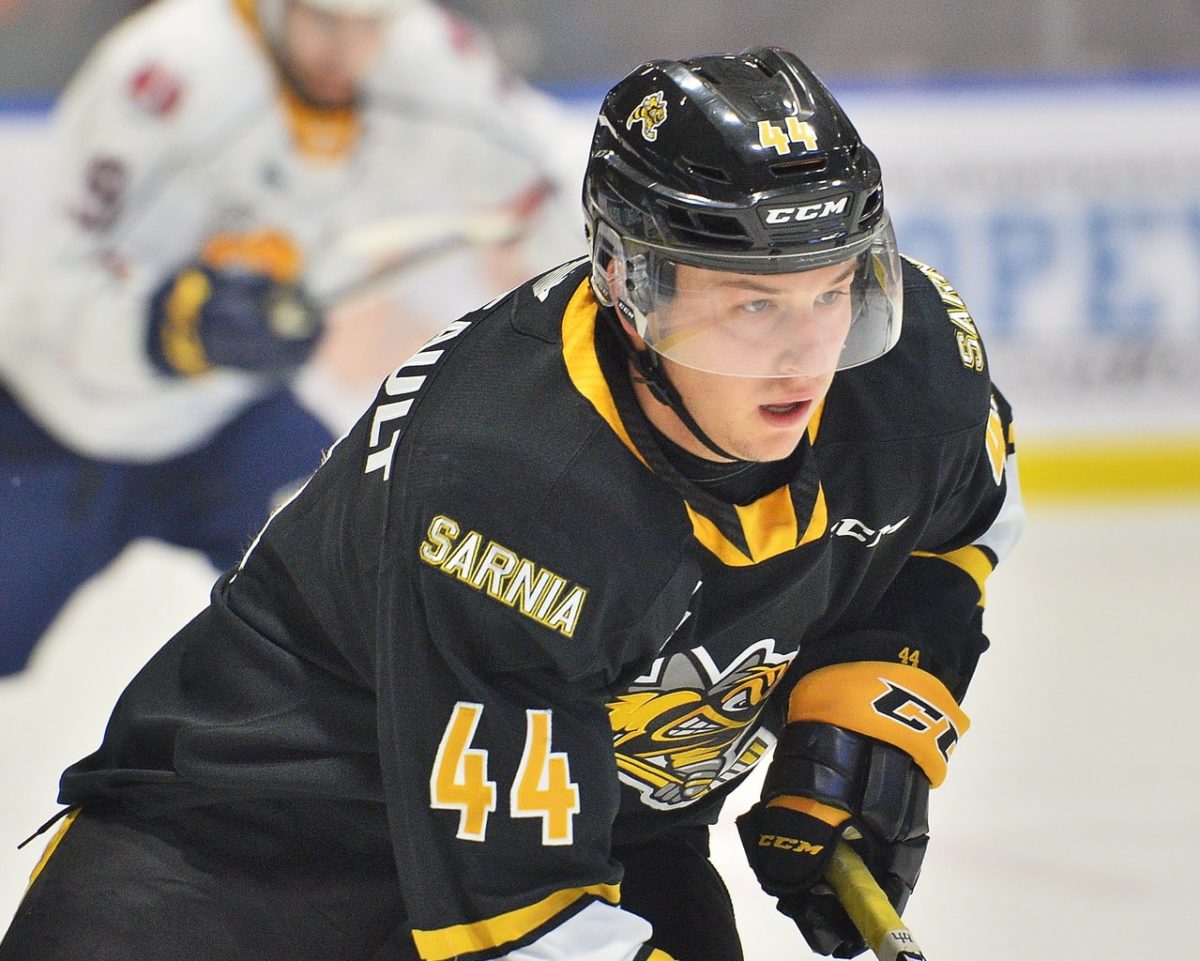
Jacob is not the same type of player his father was, at least not now. He is more of a goal-scorer, though that wasn’t as apparent this season. With the Ontario Hockey League (OHL) not starting this season, Perrault played for the Gulls. Typically, the AHL does not allow teenagers to play in the league, but an exception was made for the 2020-21 season, and since Perreault played at least 20 games in the AHL, he can play there again in 2021-22.
The OHL-to-AHL transition was not easy for Perreault. His ice time dropped from 18:20 to 13:18, and the sniper could only land 1.4 shots per game, down from 3.8 in the OHL. His shot is his best asset, as he is able to score in a variety of way from one-timers to wrist shots to shooting in stride. Even though His shots per game dropped and his Corsi percentage was under 50, he did improve in one particularly important area; his playmaking.
Known as more of a goal-scorer, it was great to see Perreault have many more assists than goals. It was actually the first time in his career that he accomplished this goal, at any level. I still think he will be a goal-scorer in the NHL, but improving his playmaking will allow his shot to be even more dangerous and he works give-and-go opportunities, while the goalies will need to respect the pass even more. Perrault should be in the AHL this season and may earn a call-up as early as this season, but he will more likely push for a roster spot on the Ducks in the 2022-23 season.
Mason McTavish was one of the biggest risers in the draft rankings this year. He was 11th on Bob McKenzies’ mid-season rankings and jumped up to 4th by the final version. The Swiss born Canadian was unable to play in the CHL since the the OHL didn’t get started so he went to his birth country to play during the 2020-21 season. His 11 points in 13 games stand out in a league against men, but perhaps more impressive is his Corsi percentage of 58. The rambunctious center didn’t shy away from contact against bigger and stronger opposition either laying down almost a hit per game.
Where McTavish really stood out this season was at the under 18 World Junior Championship. He was arguably their best forward and clearly the best draft-eligible forward on the squad claiming top player on his team along with Shane Wright (2022 eligible) and Connor Bedard (2023 eligible). His net expected goals (NxG) was 1.32 at the (U18WJC), where anything over .5 is good and 1.32 is just phenomenal. He also dished out nearly two hits a game during Canada’s run to the gold medal.
McTavish is too young for the AHL, and even though he proved he could play in Switzerland against men, he will most likely be in the OHL in 2021-22 with the Peterborough Petes. There is likely a small chance he makes the Ducks out of camp, but I’d be surprised if he played more than the nine game maximum before burning a year of his entry level contract. Most likely it will be one to two years before we see him in the NHL, and at that time expect him to be a middle-six center who will be a matchup nightmare for other teams, allowing Zegras to play a more offensive role.
On day two of the draft, the Ducks might have made onf the biggest steals of the day selecting Olen Zellweger at 34th overall. The reason he fell is no doubt that he is 5-foot-10, but that doesn’t detract from his skill. He’s an excellent skater and puck-moving defenseman, and though he only played in 11 WHL games, he still garnered 13 points.
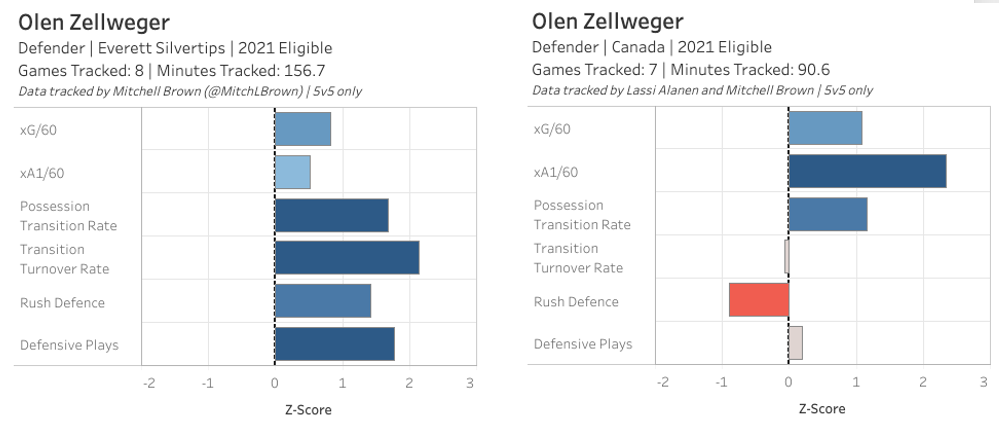
He was also a contributor to the U18WJC gold medal for Canada, picking up eight points in those seven games. You can see from Mitchell Brown’s data that Zellweger was dominant offensively at both the WHL and U18WJC this season. He struggled a little bit at the U18WJC in terms of his defensive game and that is an area where he needs to improve.
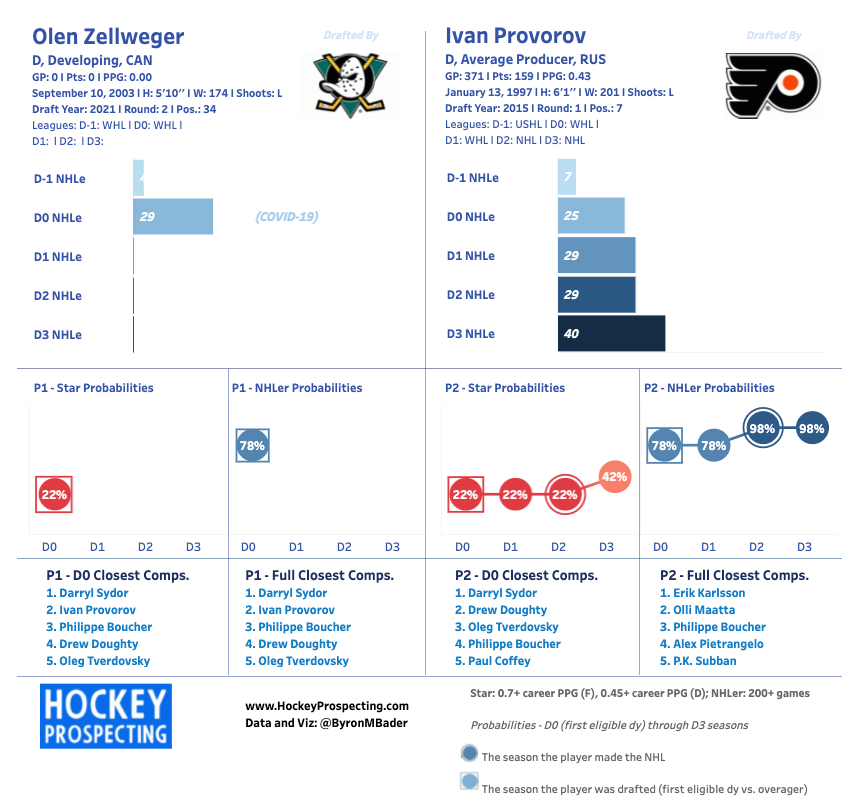
His Hockey Prospecting model compares him favorably to another WHL defender who is now an NHL regular and that is Ivan Provorov. While Provorov is a bit taller and doesn’t exactly play the same kind of game, Zellweger’s point totals suggest he has a similar chance of being an NHL star producer and NHL regular. Zellweger will no doubt need another season or two in the WHL to work on his strength and defensive game, but there is a real chance that he is a future middle-pairing defenseman.
Sasha Pastujov had to wait until 66th overall to hear his name called. This despite most outlets, including Bob McKenzie rating him as a second round talent. Consider all of that and that according to Hockey Prospecting he has a 44% star potential and 77% NHL likelihood, I think the Ducks got a steal where they selected him.
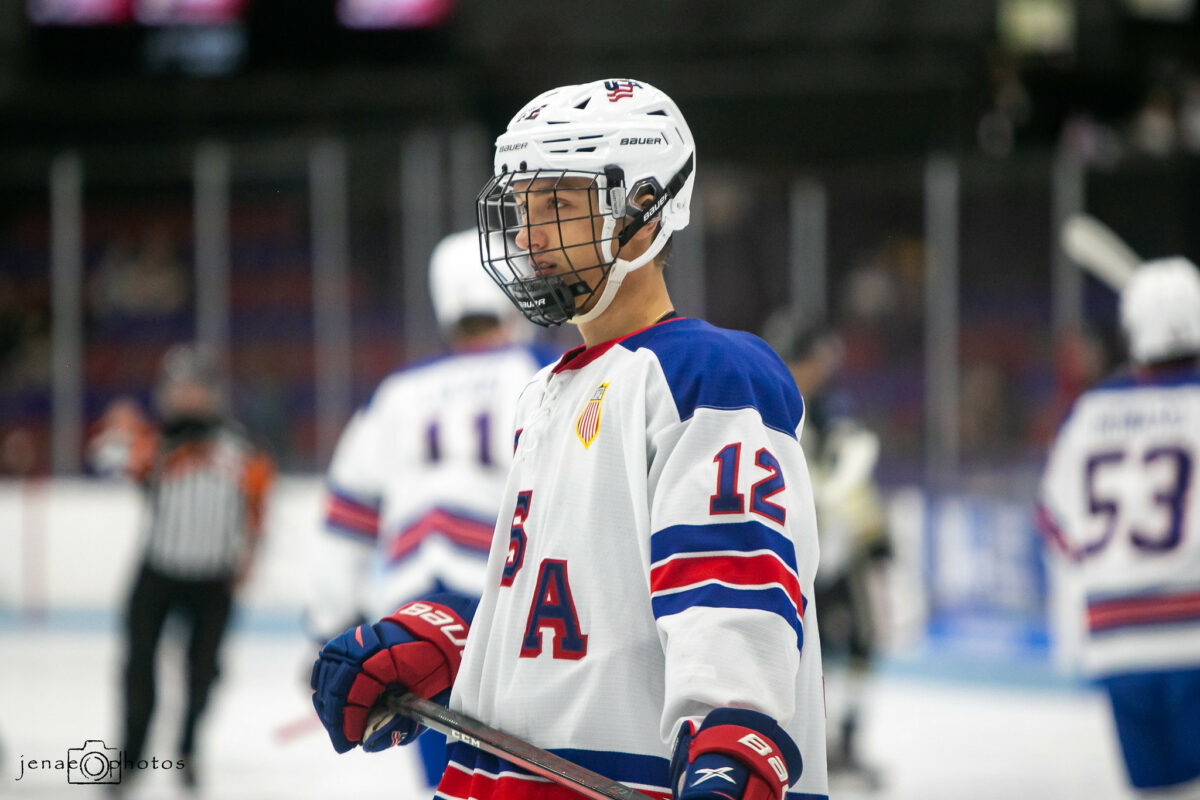
Pastujov had over a point per game for the United States National Team Development Program, including 40 goals in 59 games. According to Elite Prospects director of video scouting Cam Robinson, “he is a power play cheat code “(Fantasy Hockey Life podcast, episode 137). His biggest flaw is his skating and he will need to bring that a long way if he hopes to impact the Ducks’ power play the same way he did the USNTDP. Pastujov was going to play for the Notre Dame Fighting Irish of the NCAA, but he de-committed to play for the Guelph Storm of the OHL instead. He will need probably two-to-three more years before he can hope to crack that Ducks’ lineup, assuming of course he can dramatically improve his skating.
Tier 3: Rounding out the Top 10 – Brayden Tracey, Henry Thrun, Sam Colangelo
The 2019 29th overall pick transitioned to professional hockey this season. After 21 points in 22 games for the Victoria Royals, Brayden Tracey appeared in 12 games for the Gulls. Unfortunately, his AHL games didn’t come with any points. He also struggled to drive play with just a 42 percent Corsi, and a not great .17 NxG. The 6-foot left winger will have to improve on those numbers in the AHL before he gets a call up to the NHL. Hopefully for him that will be this season, but more likely one to two years from now.
Henry Thrun was taken 101st back in 2019 and the 6-foot defender played in 2019-20 season for the Harvard University Crimson. His 21 points in 31 games that season was an impressive first NCAA season, and we were looking forward to what his sophomore season would bring. Unfortunately, the Ivy League schools decided not to play hockey in 2020-21 so Thrun had to play in the USHL for the Bubuque Fighting Saints. He was able to put up 22 points in 24 games with a 58% Corsi and .71 NxG.
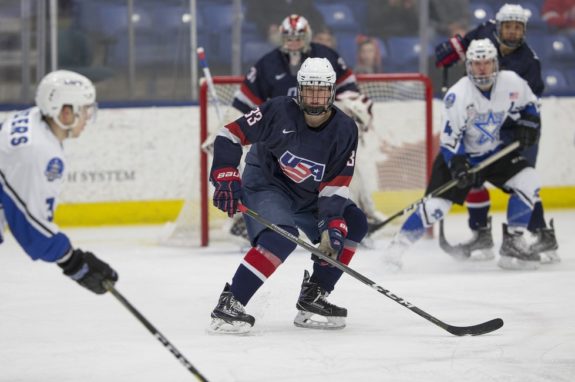
Thrun was also a member of the gold-medal winning United States U20WJC, alongside Zegras, although in a limited role. Thrun played mostly bottom pairing minutes, but was effective. That seems like a reasonable outcome for him in the NHL as well, bottom-pairing with plenty of penalty killing minutes. He will get his second Crimson season in 2021-22, so hopefully he can continue to round out his game, and perhaps earn a call up to the Ducks in two to three years.
Sam Colangelo was taken 36th overall in 2020. He, like Zegras and Thrun, won gold at the U20WJC, but suffered an injury toward the end of the tournament that limited his ability to play at Northeastern University. He managed three points in eight games for the Huskies. He fancies himself a power forward and there is work to be done with his skating, but Colangelo could be a serviceable middle-six forward for the Ducks in a few years if all breaks right.
Future outlook
The future is very bright for the Ducks. With a future starting goalie, a top pairing defender, and a first line center all realistic outcomes from their current list of prospects, it’s hard not to be excited about the future. Beyond the top tier, there are some really good depth options as well. Assuming the Ducks can develop the players in the second and third tier, they could be back to contending for the division in three to five years.
Insights by InStat